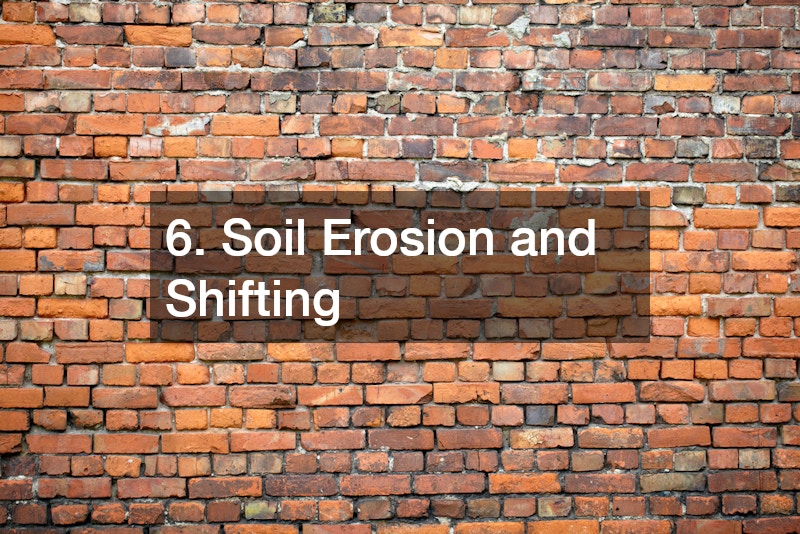Retaining walls are a vital part of landscape design, providing stability to sloped areas, preventing erosion, and enhancing the visual appeal of your property. However, when a retaining wall fails, it can lead to serious damage, safety risks, and costly repairs. Understanding why retaining walls fail is essential for homeowners, builders, and property managers alike. Here are six common reasons retaining walls fail and what can be done to prevent these issues.
1. Poor Drainage
One of the leading causes of retaining wall failure is poor drainage. Retaining walls are designed to hold back soil, but if water builds up behind the wall, it can create immense pressure that the structure cannot handle.
Water saturation can cause soil to shift, settle, or even wash away, compromising the wall’s integrity. Proper drainage solutions, such as weep holes, gravel backfill, and perforated pipes, are essential. Consulting with a professional retaining wall contractor can ensure that water is effectively redirected away from the wall, reducing the risk of failure.
2. Inadequate Foundation
A strong foundation is critical for the longevity of any retaining wall. Walls built on weak or uneven soil are prone to shifting, cracking, or collapsing over time. Foundations must be constructed with the appropriate depth and base material to support the weight of the wall and the pressure from the soil it retains. Neglecting proper foundation preparation often leads to uneven settling, which can destabilize even well-built walls. Engaging a skilled retaining wall contractor ensures that the foundation meets structural requirements and local building codes.
3. Using the Wrong Materials
Not all materials are suitable for every type of retaining wall. Wood, concrete, stone, and brick each have unique properties and limitations. Using materials that cannot withstand the environmental conditions, soil pressure, or load requirements can lead to premature failure. For instance, untreated wood may rot over time, while poorly reinforced concrete can crack under pressure. Selecting durable materials designed for your specific landscape and working with an experienced retaining wall contractor helps ensure the wall is built to last.
4. Lack of Reinforcement
Reinforcement is crucial, especially for taller walls or those supporting heavy loads. Many retaining walls fail because they are constructed without proper reinforcement, such as steel bars, geogrids, or tiebacks. These elements strengthen the wall and help it resist lateral soil pressure. Without adequate reinforcement, walls are vulnerable to bowing, leaning, or toppling over time. A retaining wall contractor can recommend the appropriate reinforcement techniques based on wall height, soil type, and intended use, providing both stability and safety.
5. Poor Design and Construction
Even with quality materials and proper drainage, a poorly designed or constructed retaining wall can fail. Factors such as wall height, slope angle, soil type, and load-bearing requirements must be carefully considered during the design phase. Mistakes during construction, such as improper leveling, misaligned blocks, or uneven backfill, can compromise the wall’s performance. Hiring an experienced retaining wall contractor ensures that the wall is designed and built according to best practices, reducing the likelihood of future problems.
6. Soil Erosion and Shifting
Soil erosion and movement are natural processes that can threaten retaining walls over time. Heavy rain, flooding, or changes in landscaping can cause soil to wash away or settle unevenly, increasing the pressure on the wall. Over time, this can lead to cracks, tilting, or complete failure. Regular maintenance, including inspecting for signs of erosion, reinforcing vulnerable areas, and addressing drainage issues promptly, is key to preventing long-term damage. A retaining wall contractor can provide ongoing guidance on maintaining soil stability around the wall.
Retaining walls are essential for managing landscapes, but they are not immune to failure. Poor drainage, inadequate foundations, improper materials, lack of reinforcement, subpar design, and soil movement are among the most common reasons walls fail. Preventing these issues requires careful planning, quality materials, and expert construction. Working with a qualified retaining wall contractor not only ensures your wall is built to last but also provides peace of mind that your property is protected. Regular inspection and maintenance can further extend the life of your retaining wall, keeping it functional and attractive for years to come.
By understanding the causes of retaining wall failure and addressing them proactively, homeowners can avoid the frustration and hazards associated with a collapsed wall, ensuring their outdoor spaces remain safe and beautiful.


